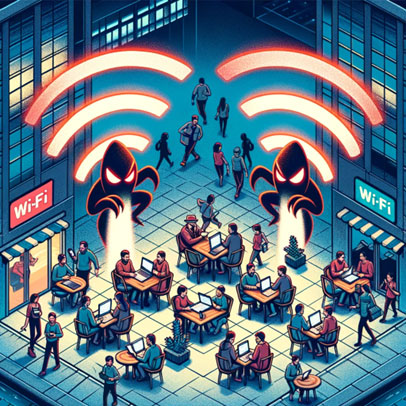
Like many modern technologies, it’s a wonder we ever got by without Wi-Fi. Before wireless connectivity, we were tethered to one spot with our computers, we couldn’t use our phones to access the Internet, and we certainly weren’t turning our lights on and off with an app. Business — and the rest of life — has gotten a lot more convenient thanks to Wi-Fi.

Watch out for Wi-Fi hacking
Unfortunately, it’s made things a lot more convenient for cybercriminals as well. There are a number of ways hackers might be able to harm your business if you don’t have the right protections in place.
Common Wi-Fi exploitations include:
- Piggybacking and wardriving: In both of these situations, someone nearby hops on your wireless network without you knowing. Piggybacking is done by someone who likely lives or works close by — wardriving is when someone drives around with a wireless device seeking out vulnerable wireless networks.
- Evil twin: A hacker sets up a public Wi-Fi network that mimics the name of an actual network nearby. For instance, a hair salon might offer a public network called Salon-Name. A hacker could set up a wireless network called Salon-Name-Customers, hoping that some people would assume that’s the salon’s Wi-Fi so they can then access the users’ devices.
- Brute force attack: A hacker tries to guess your WiFi password, which can be rather easy compared to guessing personal passwords because businesses want to make it convenient for customers to access their Wi-Fi.
When hackers do gain access to your network, it becomes their playground from there. They can access and control devices from your phone to your smart thermostat to the router itself. They can even pursue illegal activities using your network — potentially making it look like someone in your business is the criminal. To avoid problems like these, you’ve got to start with your password.

Implement Wi-Fi password best practices
Whether you have a wireless network for employee use or customer use, it’s an absolute must for you to protect it with a strong password.
Hackers make easy work of passwords for devices — and they can do it for your Wi-Fi network too. Creating a hard-to-crack password will protect your business. While employees and customers might complain that it’s cumbersome to enter a lengthy password, it’s essential to your wireless safety.
Follow these guidelines for safer Wi-Fi network passwords:
- Make it complex: Try a series of words, inserting symbols and capital letters to increase the time it would take to brute force the password — like Apple-purPle!jumP$. An 18-character password with a combination of numbers, uppercase letters, lowercase letters and symbols will take hackers 26 trillion years to guess. (79 billion years if they use ChatGPT.)
- Change it often: Change the password at least twice per year, if not more. Start fresh each time — don’t change just one character!
- Don’t broadcast it: All your hard work of creating strong passwords and diligently changing them will be lost if you post signs around your business with the login information available for anyone to see.

Get help creating a protected Wi-Fi network
If building a safe wireless network isn’t something you want on your to-do list, the Cenetric team can help. We have the expertise to make your wireless access productive and protected at the same time. Tell us about your needs and we’ll share how we can help.
This is an installment in a three-part series about keeping yourself and your company safe from data theft. Check out the rest of our series on protecting your data in emails and on mobile apps.
